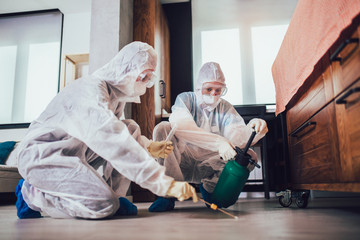Pest Control In Bakersfield is the process of reducing pest numbers and damage to an acceptable level. Threshold-based decision making focuses on scouting and monitoring, with the use of physical, biological and chemical methods as necessary.
Some mechanical or physical control methods include sticky barriers, heat killing (for storage pests), and flooding of soil to exclude ground dwelling insects. Parasitic nematodes (like the roach-eating Steinernema carpocapsae) also perform well against some pests.

Using preventive measures to stop pests before they become an issue can save money and time. Using baits and traps that are designed to attract specific pests, as well as regularly cleaning and sanitizing spaces where food is prepared or stored, can help keep pests away. Sealing cracks and crevices, removing debris, and fixing water leaks can also prevent entry points for unwanted pests.
In addition, storing foods in tightly sealed containers can disincentivize pests from seeking out an easy meal. Taking out trash frequently and rinsing cans before putting them in the bin can further deter pests. Other things that can discourage pests include keeping surfaces free of crumbs and other debris, not leaving pet food out overnight, and not spraying bushes and plants with water.
Some natural forces, such as weather and competition, may have an effect on pest populations. Generally, these forces can either help or hinder human efforts to control pests.
Monitoring is the process of checking for and identifying pests on a property or site, as well as assessing the number and extent of damage they cause. It is a critical first step in any pest control plan. Monitoring may be done in the field, on the ground or in buildings and structures. It can involve examining plant and animal communities, soil, or other materials to identify the presence of pests and their level of damage.
Pests are often controlled by reducing their numbers to an acceptable level. This can be achieved through prevention, suppression, or eradication. Typically, chemical products are used in the control of pests, but they can also be accomplished with physical or mechanical means. These controls may kill a pest directly, block it from entering, or make the environment unsuitable for it. Some examples of physical or mechanical control are use of barriers, steam sterilization of the soil, and traps for rodents.
Often, pests enter homes and businesses through cracks or crevices in walls, windows, doors, and utility lines. It is important to thoroughly inspect the interior and exterior of a building on a regular basis, paying close attention to walls, ceilings, floors, and foundations. Any areas where pests can gain access should be promptly closed to prevent them from infiltrating living or working spaces.
Often, pests must be controlled immediately because of the damage they cause. Rodents chew through insulation and make rooms feel like a port-o-potty, cockroaches contaminate food in restaurants and food prep areas, and mosquitoes can carry diseases. If you wait too long to call a pest control professional, the problem will only get worse.
Monitoring is the key to successful pest management. It allows you to identify and record the presence of a pest, how many there are, and what damage they’re doing. This information will help you determine whether to tolerate the pest or control it using other methods. Monitoring also enables you to select the most effective treatment method and time.
The most important way to keep a pest population low is by removing the food source. Store food in tightly closed containers and remove garbage from homes or businesses regularly. Keep outdoor garbage cans tightly closed and don’t let them sit in the sun. Maintain a clean environment inside and outside your home or business by removing piles of trash, fixing leaky plumbing, and keeping indoor spaces clean.
Chemical treatments, such as sprays and baits, are useful in controlling pests if non-chemical methods fail. However, routine pesticide applications in and around homes are not good unless you have a persistent pest infestation that cannot be controlled with other methods.
A less harmful and more environmentally friendly way of controlling pests is by biological controls. These are living organisms, such as nematodes and viruses, that are engineered into pesticides to kill insect populations. They can be applied directly to the soil or water to suppress pests and are used in place of chemicals.
Other biological pest control techniques include using plant pathogens, which are disease-causing microorganisms, to kill unwanted plants and animals. These organisms are injected into the soil and attack the plants by invading their cells or disrupting their metabolism. This type of control can be used in conjunction with chemical pesticides, but is usually preferred because it is safer for humans and other organisms.
Pests can be a major nuisance in homes and businesses, contributing to poor aesthetics and property damage. In addition, pests can carry diseases and spread weeds and invasive species that disrupt natural ecosystems. For these reasons, effective pest control is necessary to protect public health by reducing the risks of insect-borne disease, safeguard agriculture and food supplies, and preserve buildings, plants and crops from destruction.
Pest control methods vary depending on the type and severity of the infestation. A professional exterminator can help assemble a plan that will target the pests in question. These plans can include any combination of prevention, suppression and eradication techniques, depending on the situation.
Chemical pesticides are the fastest and most widely used method of controlling pests. These chemicals can kill or repel pests, and they may also modify a plant’s growth or remove its foliage. These products can be a valuable part of a pest management program, but it is important to understand the limitations and risks associated with them.
When using pesticides, it is critical to follow all directions on the label. Some pesticides are toxic to humans and animals, and they can also damage the environment if not applied correctly. Children, older adults and those with compromised immune systems are especially at risk for harm if they come into contact with pesticides.
Integrated Pest Management is an approach to pest control that reduces the use of pesticides. Its principles include monitoring pest populations, identifying the factors that lead to their growth and survival, and selecting and implementing cultural, biological or physical controls that limit pest growth, population increase and damage.
Physical control methods include removing or blocking access to pests’ nesting and breeding sites. They can also include changing irrigation practices to reduce the amount of water that a plant receives, which can help prevent weed and root disease problems.
Many pests are attracted to food sources, so a good way to deter them is to clean up the area around your home or business. Getting rid of food scraps, tall weeds and woodpiles can make it more difficult for pests to find shelter and food sources.
Developed in response to the steady increase of pesticide use that resulted in pest control crises (outbreaks of secondary pests, resurgence of target pests after developing resistance to chemicals), IPM emphasizes preventive and nonchemical methods. It is a comprehensive, systemic approach that incorporates biological, cultural, physical, and crop specific management strategies and tactics to reduce the occurrence of pests below economic injury levels. IPM programs are applicable to all environments—agriculture, horticulture, ornamentals, and natural areas.
The IPM approach to pest control starts with a thorough understanding of the pest, including its biology, life cycle, and damage potential. This knowledge allows for the selection of less risky pest control options, such as pheromones to disrupt mating or trapping, prior to using more intensive controls. IPM also relies on regular scouting to identify pest populations and monitor crop health, which helps avoid the need for unnecessary treatment.
Once the pest population has exceeded an action threshold, IPM programs evaluate the appropriate control method in terms of both its effectiveness and the risk it poses to people, animals, or plants. Effective, lower risk control methods are selected first, such as fungicides to prevent disease on roses or bait pellets for slugs and snails. More intensive treatments, such as targeted or broadcast spraying of pesticides, are used only when previous, safer control methods have failed.
IPM is important because of the growing concerns about reducing human exposure to toxic chemicals, especially in settings frequented by children, such as schools and parks. Many children suffer from asthma attacks and other respiratory problems triggered by cockroaches and rodent infestations. Others are exposed to excessively high doses of pesticides in agricultural fields or on lawns maintained with commercial chemical products. IPM can help reduce the risks of exposure to pesticides in these settings and help provide healthier food and a cleaner environment. For more information on IPM, visit the UC IPM website for resources, trainings, and monitoring tools for almost all major pests. UC IPM also supports the dissemination of research-based information through its network of Cooperative Extension advisors and specialists across the state.

 Pests can be annoying, but they also pose real health risks. The best way to deal with them is to prevent them from getting into your home in the first place. Contact
Pests can be annoying, but they also pose real health risks. The best way to deal with them is to prevent them from getting into your home in the first place. Contact